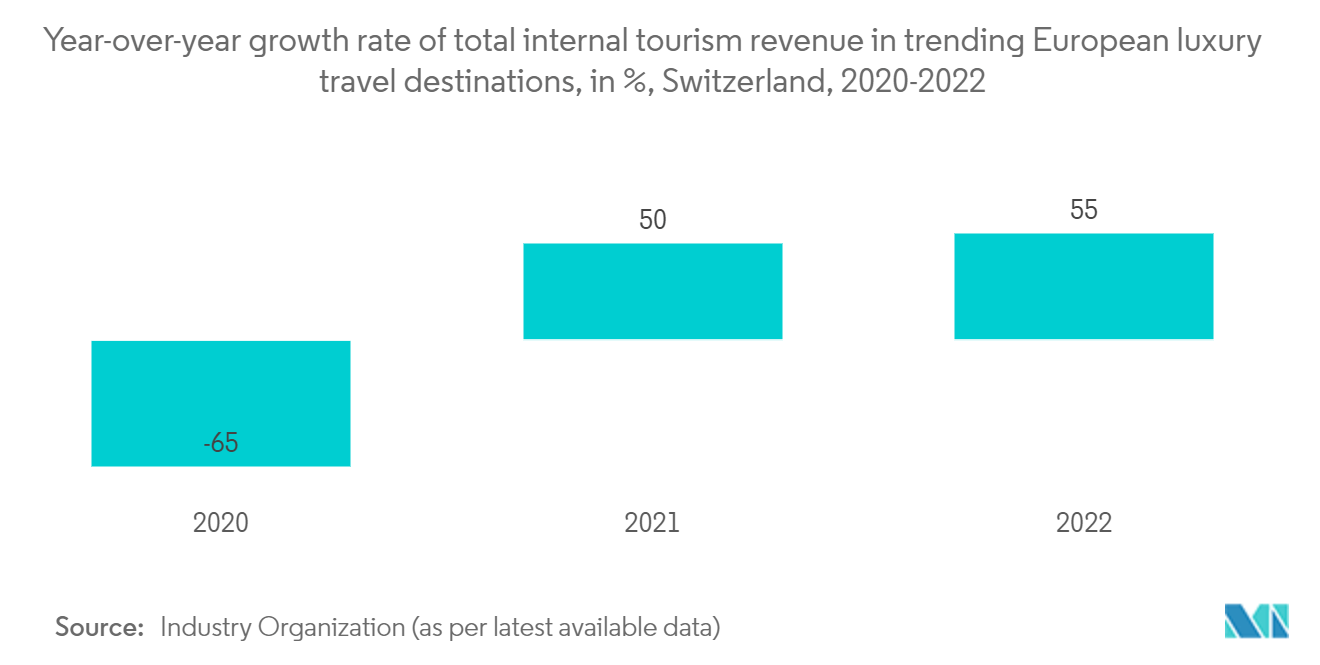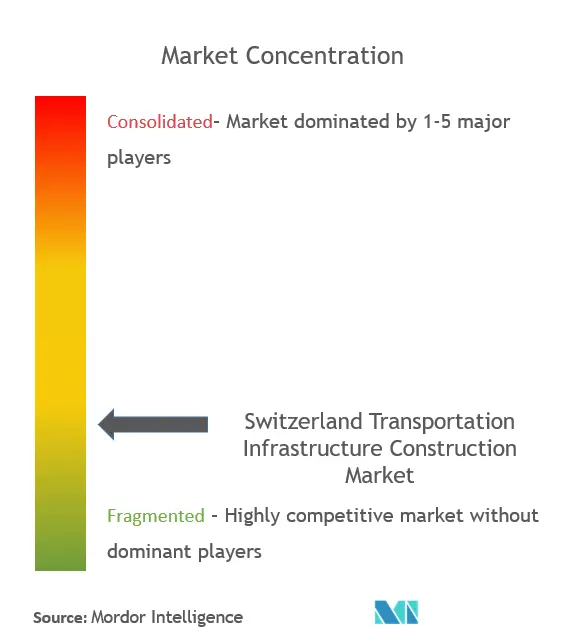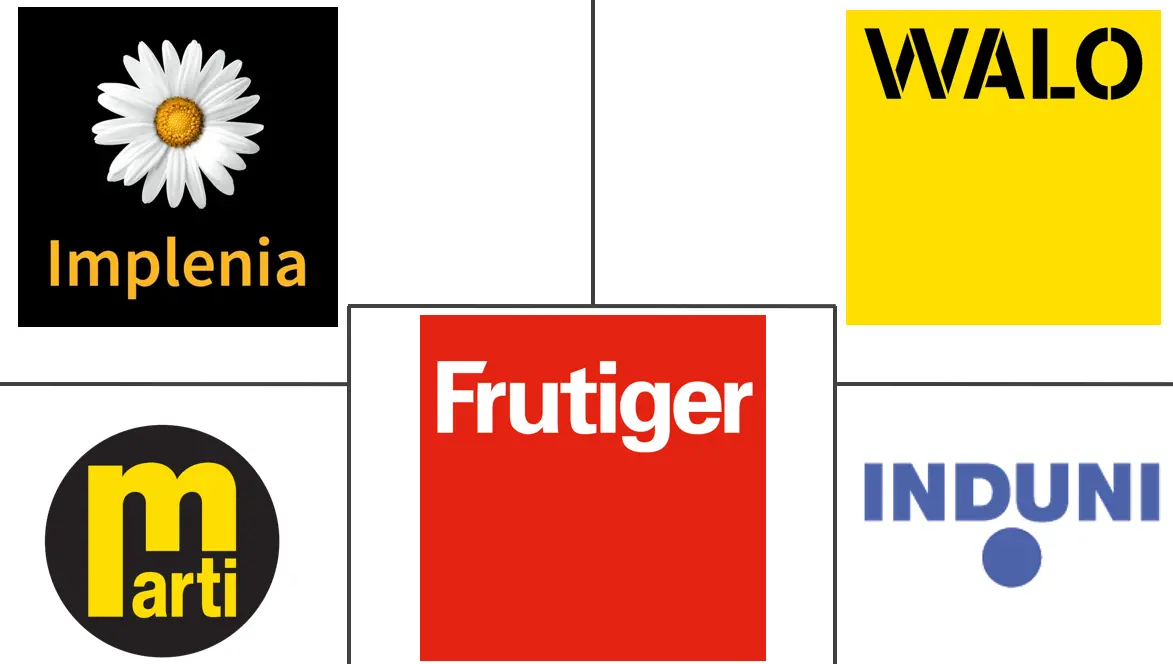
Switzerland Transportation Infrastructure Construction Market Analysis by Mordor Intelligence
The Switzerland Transportation Infrastructure Construction Market size is estimated at USD 20.07 billion in 2025, and is expected to reach USD 26.39 billion by 2030, at a CAGR of 5.63% during the forecast period (2025-2030).
The Swiss economy contracted by 2.9% in 2020, the worst downturn in more than 40 years, as the COVID-19 pandemic battered the service sector. Smaller trade companies and large construction companies were also equally affected by the pandemic. Even though there were only isolated construction site closures due to the coronavirus, the companies affected were exposed to considerable additional costs. The government mobilized a massive aid package to help the economy, spending nearly 15 billion Swiss francs (USD 16.58 billion) in 2020 on schemes such as support for short-time work and loss of earnings.
Compared to those of other countries, the Swiss transport infrastructure is highly developed. They occupy just over 2% of the national territory and almost a third of the housing and infrastructure areas. In 2022, the length of the road network was 84,600 km, including 1,544 km of motorways and about 17,200 km of cantonal roads. Compared with the road network, the Swiss rail network "only" covers about 5,300 km. In the field of air traffic, the three airports of Zurich, Geneva, and Basel provide connections with European and world airports. The eleven regional airfields are primarily used for business flights, pleasure flights, and work flights. The infrastructure is further complemented by 126 km of rack railways, 316 km of tram tracks, 1037 km of cable transport lines, and 109 km of oil pipelines.
Over the next 25 years, an underground freight transport system is to be built right across Switzerland, which will significantly relieve the burden on motorways and railways. Political support for the freight metro is also in place: the Federal Council decided to create the legal basis for CST in January 2020. The project schedule is ambitious: the first section from Zurich to Harlingen is due to go into operation in ten years.
Switzerland Transportation Infrastructure Construction Market Trends and Insights
Population Growth and Urbanization are Driving the Market
The increasing population and urbanization in Switzerland have led to a rise in the demand for efficient transportation infrastructure to support the growing mobility needs of people and goods.
The proportion of mountain roads, bridges, and tunnels has increased significantly, construction difficulty has increased significantly, and safety risks have increased. However, in order to optimize domestic transportation, Switzerland will vigorously build transportation infrastructure.
According to industry sources, in 2022, the total population of Switzerland amounted to around 8.74 million people, with a projection of 8.94 million people by 2025. In 2022, Switzerland’s urban population accounted for approximately 74.09% of the country’s population. However, 2022 still marks the highest urban population share in Switzerland at 74.09%.
For this, Switzerland is setting a budget for major road development work between 2024 and 2027. The Swiss Government intends to spend close to EUR 8 billion (USD 8.57 billion) on developing the country’s road network. Road maintenance works will be carried out on the existing road sections, while expansion and widening works will also be carried out. New road links and overpasses are also planned.
The Swiss Highway 3 is a highway connecting Liechtenstein to Basel, passing through Zurich, and passing through Lake Zurich, known as the "Golden Bank," and Lake Waren, "the quietest lake in Switzerland." Famous glacial lake in Switzerland. In the northeastern part of the Swiss Plateau, it extends southeast from the city of Zurich. The lake is 406 meters above sea level. It is crescent-shaped and extends 29 kilometers from southeast to northwest, with a width of 1-4 kilometers and an area of 88 square kilometers.

Airport Infrastructure Driving the Market
Switzerland is a landlocked country located in central Europe. Foreign tourists accounted for approximately 5.3% of the income generated by exports in Switzerland. This places tourism in the 3rd position of Swiss exports. The Alps are also among the most visited regions. About 60-80 million people visit the Alps each year as tourists. Tourism activities in the Alps generate close to EUR 50 billion in annual turnover.
The busiest airports in Switzerland are Zurich, Geneva, and Basel. Zurich Airport had the lion's share of passengers in 2019, with more than 31.5 million passengers flying from the airport. Following Zurich, Geneva was the second-busiest Swiss airport, with 22.6 million passengers in 2022.
Zurich Airport, the largest international airport in Switzerland, is undergoing a series of developments to meet future air travel demand. Operated by Flughafen Zurich, the international airport is currently carrying out the Zone West project, which mainly aims to improve aviation hangar space. The airport is also expanding the baggage sorting system, constructing a new retail and commercial space called The Circle, expanding landside passenger zones, and developing the nearby Glatt area.
In July 2021, Zurich Airport International signed a shareholder agreement with the Uttar Pradesh government's entity NIAL in Lucknow for the development of the Noida International Airport.
Geneva Airport in Switzerland will officially inaugurate its new East Wing this spring after more than a decade of design and construction. Praised for its green credentials, the new CHF 610m (USD 666 million) East Wing hosted its first flight in December 2021 with an international departure for New York. The glass-walled rectangular facility stretches 520m in length and can accommodate nearly 2,800 passengers an hour at departures and 3,000 at arrivals.

Competitive Landscape
The Switzerland Transportation Infrastructure Construction Market is fragmented, owing to the presence of major local and international players. Implenia Schweiz AG, WALO, Induni & Cie SA, Cellere-Gruppeare, and Georges Chetelat SA are among the major players in the market. In the transportation infrastructure market, demand for sustainability and technical developments has increased, and companies are investing to stay competitive. The market offers chances for upcoming businesses because of rising government investments in the industry. The market presents opportunities for growth during the forecast period, which is expected to drive market competition further.
Switzerland Transportation Infrastructure Construction Industry Leaders
-
Implenia Schweiz AG
-
WALO
-
Marti Holding AG
-
Frutiger Unternehmungen AG
-
Induni & Cie SA
- *Disclaimer: Major Players sorted in no particular order

Recent Industry Developments
- Aug 2023: Implenia and WindWorks Jelsa signed an investment and shareholder agreement to develop a state-of-the-art facility for the production and assembly of large concrete or steel structures for floating offshore wind turbines on Norway's west coast. Implenia and NorSea will become minority shareholders of WindWorks Jelsa in equal shares (approx. 41% each). Norway is one of Implenia's core markets for complex infrastructure projects. NorSea is a driving force in the field of renewable energy, an innovative supply chain partner, and a successful developer of industrial parks.
- Aug 2023: The ARGE IBD, consisting of the partners Implenia (lead), Bernasconi, and De Luca, was awarded the contract for lot 2, “Tunnel Ligerz,” by the SBB. The total order volume is CHF 220 million, and Implenia's share is around CHF 150 million. The contract covers the 2.1 km long double-track tunnel - around 1,850 m of which is constructed using mining methods and around 250 m using open-cast mining, including concrete cladding and railway technology. In addition, four escape tunnels will be built, a 114 m long viaduct for the N5 motorway exit, and various additional structures. The excavated material will be transported by ship, and the existing railway line will be dismantled and redesigned.
Switzerland Transportation Infrastructure Construction Market Report Scope
The transportation infrastructure construction market includes a wide range of construction activities involving reforming existing constructions, building new infrastructures, and extending or demolishing projects. A complete assessment of the Switzerland Transportation Infrastructure Construction Market includes an overview of the economy market, market size estimation for key segments, and emerging trends in the market segments in the report. The report sheds light on the market trends like growth factors, restraints, and opportunities in this sector. The competitive landscape of the Switzerland Transportation Infrastructure Construction Market is depicted through the profiles of active key players. The report also covers the impact of COVID–19 on the market and future projections.
The Switzerland Transportation Infrastructure Construction Market is segmented By Type (Roadways, Railways, Ports and Inland Waterways, and Airways). The report offers the market size in value terms in USD for all the abovementioned segments.
| Roadways |
| Railways |
| Airports |
| Ports and Inland Waterways |
| By Type | Roadways |
| Railways | |
| Airports | |
| Ports and Inland Waterways |
Key Questions Answered in the Report
How big is the Switzerland Transportation Infrastructure Construction Market?
The Switzerland Transportation Infrastructure Construction Market size is expected to reach USD 20.07 billion in 2025 and grow at a CAGR of 5.63% to reach USD 26.39 billion by 2030.
What is the current Switzerland Transportation Infrastructure Construction Market size?
In 2025, the Switzerland Transportation Infrastructure Construction Market size is expected to reach USD 20.07 billion.
Who are the key players in Switzerland Transportation Infrastructure Construction Market?
Implenia Schweiz AG, WALO, Marti Holding AG, Frutiger Unternehmungen AG and Induni & Cie SA are the major companies operating in the Switzerland Transportation Infrastructure Construction Market.
What years does this Switzerland Transportation Infrastructure Construction Market cover, and what was the market size in 2024?
In 2024, the Switzerland Transportation Infrastructure Construction Market size was estimated at USD 18.94 billion. The report covers the Switzerland Transportation Infrastructure Construction Market historical market size for years: 2019, 2020, 2021, 2022, 2023 and 2024. The report also forecasts the Switzerland Transportation Infrastructure Construction Market size for years: 2025, 2026, 2027, 2028, 2029 and 2030.
Page last updated on:
Switzerland Transportation Infrastructure Construction Market Report
Statistics for the 2025 Switzerland Transportation Infrastructure Construction market share, size and revenue growth rate, created by Mordor Intelligence™ Industry Reports. Switzerland Transportation Infrastructure Construction analysis includes a market forecast outlook for 2025 to 2030 and historical overview. Get a sample of this industry analysis as a free report PDF download.



